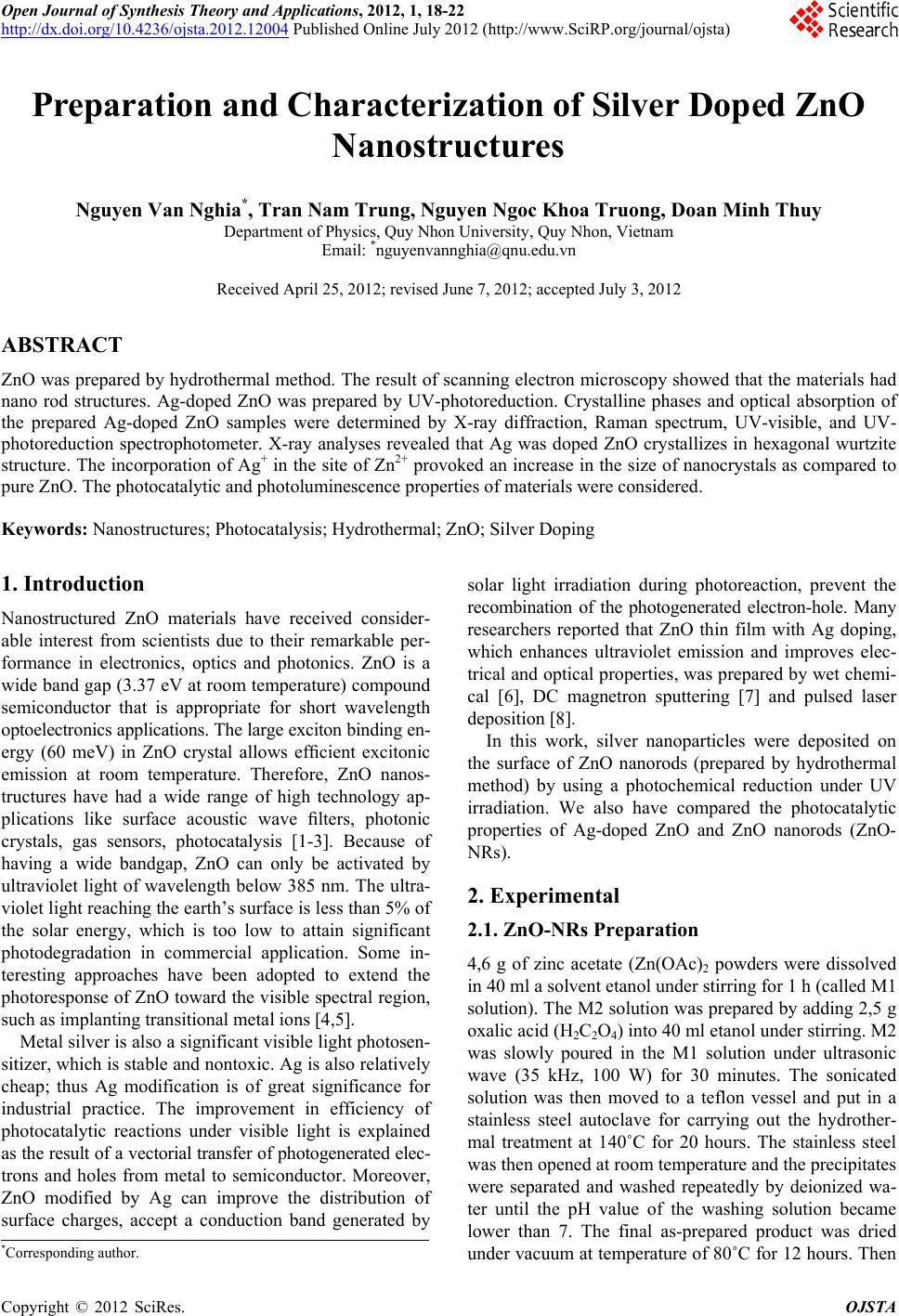
Open Journal of Synthesis Theory and Applications, 2012, 1, 18-22
http://dx.doi.org/10.4236/ojsta.2012.12004 Published Online July 2012 (http://www.SciRP.org/journal/ojsta)
Preparation and Characterization of Silver Doped ZnO
Nanostructures
Nguyen Van Nghia*, Tran Nam Trung, Nguyen Ngoc Khoa Truong, Doan Minh Thuy
Department of Physics, Quy Nhon University, Quy Nhon, Vietnam
Email: *nguyenvannghia@qnu.edu.vn
Received April 25, 2012; revised June 7, 2012; accepted July 3, 2012
ABSTRACT
ZnO was prepared by hydrothermal method. The result of scanning electron microscopy showed that the materials had
nano rod structures. Ag-doped ZnO was prepared by UV-photoreduction. Crystalline phases and optical absorption of
the prepared Ag-doped ZnO samples were determined by X-ray diffraction, Raman spectrum, UV-visible, and UV-
photoreduction spectrophotometer. X-ray analyses revealed that Ag was doped ZnO crystallizes in hexagonal wurtzite
structure. The incorporation of Ag+ in the site of Zn2+ provoked an increase in the size of nanocrystals as compared to
pure ZnO. The photocatalytic and photoluminescence properties of materials were considered.
Keywords: Nanostructures; Photocatalysis; Hydrothermal; ZnO; Silver Doping
1. Introduction
Nanostructured ZnO materials have received consider-
able interest from scientists due to their remarkable per-
formance in electronics, optics and photonics. ZnO is a
wide band gap (3.37 eV at room temperature) compound
semiconductor that is appropriate for short wavelength
optoelectronics applications. The large exciton binding en-
ergy (60 meV) in ZnO crystal allows efficient excitonic
emission at room temperature. Therefore, ZnO nanos-
tructures have had a wide range of high technology ap-
plications like surface acoustic wave filters, photonic
crystals, gas sensors, photocatalysis [1-3]. Because of
having a wide bandgap, ZnO can only be activated by
ultraviolet light of wavelength below 385 nm. The ultra-
violet light reaching the earth’s surface is less than 5% of
the solar energy, which is too low to attain significant
photodegradation in commercial application. Some in-
teresting approaches have been adopted to extend the
photoresponse of ZnO toward the visible spectral region,
such as implanting transitional metal ions [4,5].
Metal silver is also a significant visible light photosen-
sitizer, which is stable and nontoxic. Ag is also relatively
cheap; thus Ag modification is of great significance for
industrial practice. The improvement in efficiency of
photocatalytic reactions under visible light is explained
as the result of a vectorial transfer of photogenerated elec-
trons and holes from metal to semiconductor. Moreover,
ZnO modified by Ag can improve the distribution of
surface charges, accept a conduction band generated by
solar light irradiation during photoreaction, prevent the
recombination of the photogenerated electron-hole. Many
researchers reported that ZnO thin film with Ag doping,
which enhances ultraviolet emission and improves elec-
trical and optical properties, was prepared by wet chemi-
cal [6], DC magnetron sputtering [7] and pulsed laser
deposition [8].
In this work, silver nanoparticles were deposited on
the surface of ZnO nanorods (prepared by hydrothermal
method) by using a photochemical reduction under UV
irradiation. We also have compared the photocatalytic
properties of Ag-doped ZnO and ZnO nanorods (ZnO-
NRs).
2. Experimental
2.1. ZnO -NRs Preparation
4,6 g of zinc acetate (Zn(OAc)2 powders were dissolved
in 40 ml a solvent etanol under stirring for 1 h (called M1
solution). The M2 solution was prepared by adding 2,5 g
oxalic acid (H2C2O4) into 40 ml etanol under stirring. M2
was slowly poured in the M1 solution under ultrasonic
wave (35 kHz, 100 W) for 30 minutes. The sonicated
solution was then moved to a teflon vessel and put in a
stainless steel autoclave for carrying out the hydrother-
mal treatment at 140˚C for 20 hours. The stainless steel
was then opened at room temperature and the precipitates
were separated and washed repeatedly by deionized wa-
ter until the pH value of the washing solution became
lower than 7. The final as-prepared product was dried
under vacuum at temperature of 80˚C for 12 hours. Then
*Corresponding author.
C
opyright © 2012 SciRes. OJSTA